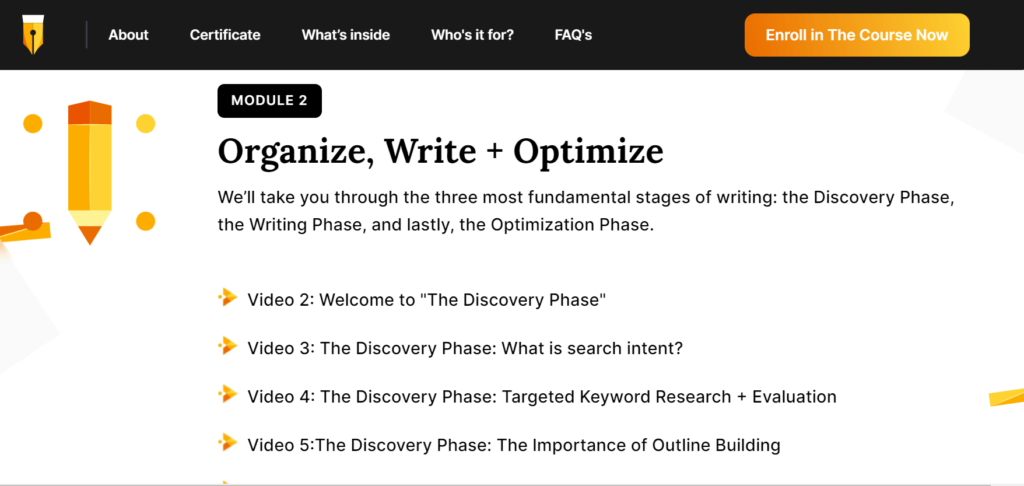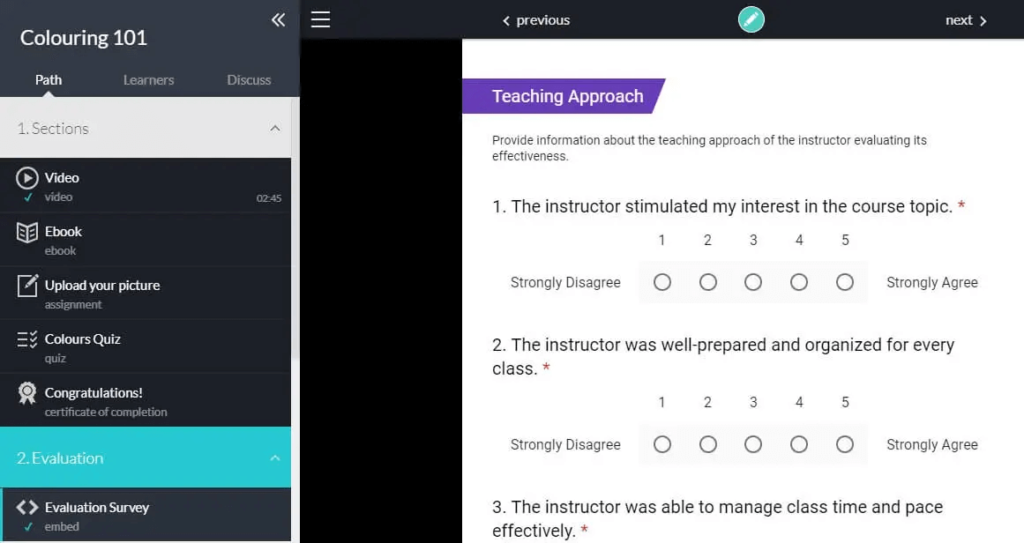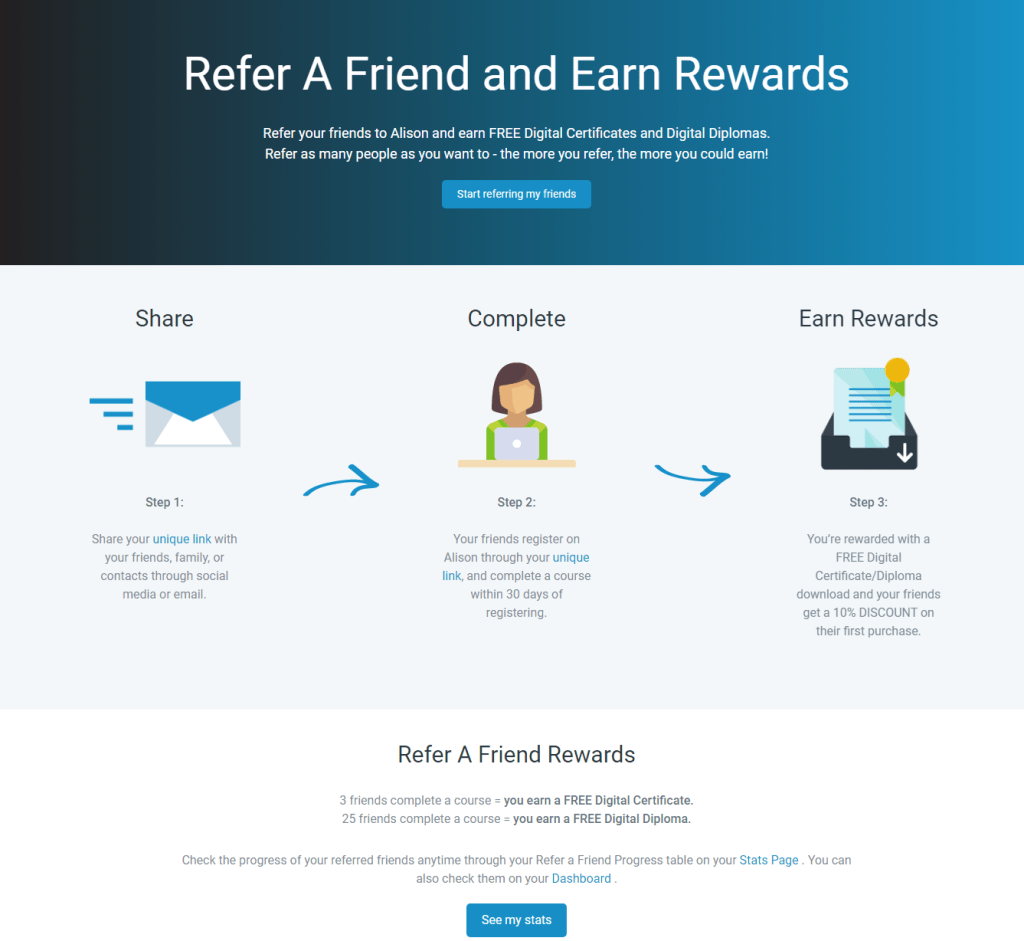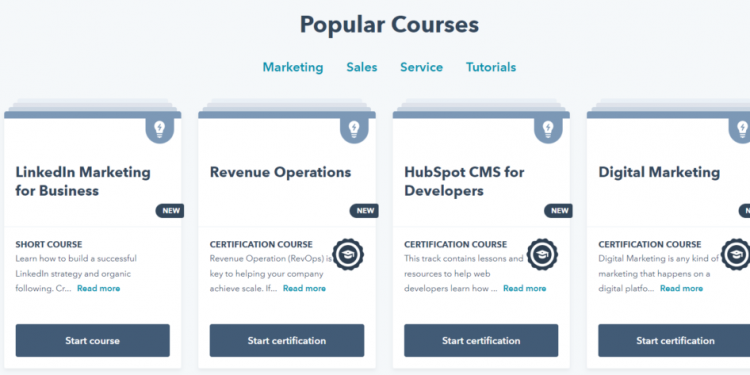Knowing how to sell online courses successfully is an excellent way to make money online and grow your brand. As long as you have some expert knowledge on a certain topic, you can use this to create an online course and use it to generate revenue (or leads for your business).
It sounds pretty straightforward, and it actually is. You just need to take the right steps and focus on the most effective sales strategies.
In this guide, we’ll break down the steps you need to take to create an online course and sell courses online. Do it right, and it can be one of the most rewarding ways to grow your online business.
- Why Create and Sell an Online Course?
- How to Sell an Online Course in 9 Steps
2.1) Choose a Course Idea That Sells
2.2) Create Your Online Course
2.3) Find a Place to Host and Sell Your Course
2.4) Establish a Price for Your Course
2.5) Increase the Value Of Your Online Course
2.6) Launch Your Online Course
2.7) Marketing Your Online Course
2.8) Create a Strategic Buyers Journey
2.9) Ask for Feedback and Reviews - Tips for Selling Online Courses
3.1) Create a Referral Program
3.2) Build a Community
3.3) Update Your Online Course Frequently
3.4) Create Supporting Content Around Your Course
3.5) Use Your Course to Sell More Courses
Why Create and Sell an Online Course?
Successful online course creation is an awesome way to make money online.
eLearning is huge, and right now, people are looking to develop their skills more than ever. This means there’s a definite market for online courses. With the right online course, you have the potential to make a lot of money.
Not only this, but online courses are also great ways to improve trust and authority around your brand. If your business is a specialist in a certain area, offering a course on the topic only enhances your level of specialization. You could even give away free courses to your target audience and use the course as a way to attract leads and make more sales.
So successful online courses can help you grow your brand and make more money at the same time. And once you’ve created your own online course, it doesn’t take a lot of time and effort to sell it. You just need to follow the right strategies.
How to Sell Online Courses in 9 Steps
With the right idea and strategy, selling online courses doesn’t have to be a challenge. Here is the best approach to selling a course online, broken down into the nine most important steps you need to follow.
1. Choose a Course Idea That Sells
The best way to sell courses online is to make sure there’s a market for your course in the first place. This is rule number one.
Start by carefully choosing your course subject. Really, this comes down to understanding your audience. Reach out to your audience and understand what they are interested in learning about. Try to create a course in a subject where there is the most demand.
Of course, you also have to make sure you deliver a course on a subject that you know a lot about. The most successful courses are ones that offer actual expert information. If you’re not an expert on the topic, nobody will trust you to run a course on the subject.
So, look at what your business does and what types of problems your customers typically face. This is where you will find your best course material.
If you have other types of content out there, like blog posts, videos, or podcasts, look at what subjects gained the most popularity. You already know that these subjects are high in demand, so they will be a good idea for basing a course on.
Remember, people want to take online courses for three main reasons:
- To get certified in a certain subject
- To expand on an existing skill
- To learn a new skill
Unless you are able to offer recognized certifications, you will be focused on reasons 1 and 2. Keep this in mind when choosing a subject.
Top Tip: Being as niche as possible often helps. The more broad your course subject is, the more competition there will be. By choosing a niche topic, you will be able to offer more expert, unique advice that many other courses don’t cover. This will also help you find your ideal customers more easily.
2. Create Your Online Course
You know what your online course will be about, so now it’s time to put it together. This is a major step and possibly the most important one. This is because if your online course material isn’t any good, nobody will want to buy it.
Once you’ve chosen your course subject, zoom in on it, and refine it into a specific area or skill. Then, make sure you actually have experience and knowledge in this area!
Then understand the format of your course. This will typically be in video format, but you could also run audio or written courses.
Next, write out the course material you’ll cover and include your quiz at the end. Ensure you cover all of the right information.
Focus on production quality. If you’re making videos, make sure they are high-quality videos. Pay attention to the camera you use, the lighting, and the edits you create. This all adds to the overall trustworthiness and quality of the course.
Practice your course, do a test recording, and then put together the final version. If you’re filming this, try to be natural and talk with enthusiasm. Nobody enjoys a boring teacher.
While anyone can quickly put together a course with their smartphone camera and knowledge, try to be as professional as possible when creating your course. This is your product and it’s something that represents your brand. Most importantly, it also represents your knowledge and expertise. If your course is not produced at a high level, it might make you look less professional within your field of expertise.
 Example of a video course outline
Example of a video course outline
Top Tip: When creating online courses, consider keeping them short and focused on a highly targeted subject. This way, you can easily create a greater variety of courses, and even possibly string them together for one mega course. If you try to cover too much content in one course, it could be overwhelming and lack real value.
3. Find a Place to Host and Sell Your Course
You need to have a place where you will sell online courses from. Once you’ve created the course, you need to host it somewhere that is accessible and looks professional with your branding.
Many online courses are sold through specialized online course platforms and marketplaces. This can be a good way to reach more customers, but there are downsides. These platforms have many restrictive rules, they take a chunk of your revenue, and you can’t use your course as a valuable lead generation tool.
This is why hosting and selling the online course on your own website is a great idea. This requires a bit of setting up, but you get total freedom over how you will sell and market your course.
So, what will you need to sell online courses from your website? Here are a few essential elements:
- A landing page: You will need a dedicated landing page that sells the course
- A gated lead generation form: Course customers will need to add in their details (like their name and email address), and they can access the online course in return
- Integrated leads database: Once the customer signs up for the course, you want to capture their email address for marketing purposes. Make sure your form ads all course sign-ups to a list.
- Payments tool: If you’re just selling an online course, you won’t need a complete eCommerce website. Instead, you’ll just need the ability to accept payments from your landing page when people purchase the course.
- Marketing tools: You will need to have various marketing functions available on your website, like popups and an email marketing solution, to help you promote and sell online courses. We’ll cover this in more detail later.

With a platform like Wishpond, you can get all of these elements included in one. Wishpond includes a website and landing page builder to create your online course page, online forms to capture lead information; a leads database, a payments tool, and a wide range of marketing features. This makes it easy to get your course up and selling through a single platform.
4. Establish a Price for Your Course
How much are you going to charge for your online course?
Online courses generally sell for anywhere between $5 to $2000. How will you know which price point matches your course?
This can be a tricky part of selling online courses. One of the best things to do is to take a look at your competition a see what similar courses are selling for. However, the only real way to establish the perfect price point is to get your course out there and adjust your price as you go.
Consider how much it costs for you to create the course, and think about your target audience. Try to establish what they would want to pay for your course based on their demographics.
You could even give away your course for free in exchange for information – this is something that many businesses do to grow their email lists.

5. Increase the Value Of Your Online Course
If your goal is to make money selling online courses, then there are a few ways that you can add additional value to the course. This could be through including bonus materials or upsells in the course.
For example, you could add a few bonus lessons at the end of the course or an additional price. You could even team up with another online course provider and sell a few lessons in collaboration with them.
There are also options to a upsells to your courses. This could include things like one-on-one coaching or live group training. You still sell the same course, but you can charge more for it with these added extras.

6. Launch Your Online Course
It’s the moment you’ve been waiting for – the time to launch your online course! Congratulations, you can start selling online courses.
Well, not really. You’ll still need to attract customers through marketing.
The launch phase is about making sure your course is out there, available, and that it works. Test the course out and identify any possible issues. Once it’s ready, it’s time to market your online course.
7. Marketing Your Online Course
One of the most important steps in selling online courses is marketing the course. Because no matter how great your course is, nobody will buy it if they don’t know that it exists.
Marketing your online course is all about attracting the right customers and developing relationships with them until they’re ready to purchase the online course. There are many ways to do this.
Here are some of the most important strategies to take when marketing and selling online courses.
- Optimize your website: Ensure your course sales landing page is optimized for conversions and SEO. Keep your copy simple and punchy, and highlight the benefits of the course. Optimizing the page around a specific keyword is a good idea.
- Promote your course with marketing content: You have many channels available to create useful content for your course. Publishing helpful content that is available to the public helps you establish authority and expertise in your chosen subject. This is a great way to promote and sell your courses. Content can include blog posts, videos, social media content, podcasts, and more. Plug your online course in this content, and use the content to establish trust and authority.
- Focus on email marketing: Email remains one of the best marketing channels. It’s a powerful marketing tool to promote your online course to the right people. It can also be used to upsell additional online course material and products to those who bought your online course. You could send regular newsletters to establish authority and build trust in your topic. You could also set up an automated email sequence that gets sent to new subscribers – warming them up and eventually selling your online course.
- Add strategic website popups: Add popups on your web pages that promote your online course. This can help you drive a lot more traffic to your course landing page.
These are just a few ways to market and sell courses online. The most important thing is to understand your target audience, what their interests are, and how they behave online.
Once you know your target audience, this can help you establish whether you should focus on selling on TikTok, LinkedIn, email, or through your podcast (to name a few channels). Understanding your market and target audience will also help you optimize your buyer’s journey.

8. Create a Strategic Buyers Journey
It’s important to create an online course buyers journey when planning your marketing efforts. The buyer’s journey represents the series of choices or steps that a potential customer makes when researching their purchase.
This typically involves:
- Awareness: The customer has identified a problem and starting to look for a solution
- Consideration: The customer actively looks for a solution to their problem
- Decision: The customer makes a decision to purchase
Your online course marketing strategy should meet your customers at each stage of this journey with the right content.
First, create educational content around awareness. This can include videos, blog posts, and things that your potential customers will be searching for.
Second, build trust and authority in the consideration stage. A customer testimonial about your course can be ideal here.
Finally, push the customer into buying the course. This could be through an FAQ video that answers all of their questions, strategic email content, or more.
By understanding your target audience, you will be able to create a carefully crafted buyer journey. This will help you make a greater impact than simply throwing out random marketing content.
9. Ask for Feedback and Reviews
At this stage, your course is established, and you have a clear marketing plan in place. Now you can sell courses online!
Once you’ve started making sales, the process isn’t over. The final step is to optimize your course for even more sales. The best way to do this is to gather feedback, reviews, and testimonials.
Ask your course participants what they thought of the course and gather feedback that could help you make the course better.
Asking for reviews and testimonials is also incredibly important. Adding a few positive reviews or testimonials to your online course landing page can make a major difference to your sales.

Image: Learnworlds.com
Tips for Selling Online Courses
We’ve outlined the main steps you should take to sell courses online. While this approach is effective. There are many additional tips and tricks that you can use to sell more online courses and create a more profitable online business.
Here are a few of the best strategies to remember when you sell courses online.
Create a Referral Program
A referral program can help you spread your online course like wildfire.
Referral programs work by getting your existing customers to refer your courses for an incentive. For example, you could offer a 10% discount on additional courses or free bonus course material for every successful referral. The customer then sends a link to your course to all of their friends.
The friends receive the link to sign up for the course and pass along the link to all of their friends. And so the course reaches more and more people without any effort from your side.
With the right incentive and an easy referral campaign, this can make an incredible impact. Take a look at our referral marketing tips for more information on this.

Some of the best online courses include a community built around the course. It’s not just about completing the course but being able to connect with like-minded individuals, interact with, and support other students.
You could simply create a social media group and add all new course participants to it. This is a great way to provide more value without having to do much.
Update Your Online Course Frequently
It’s best to update your course at least once a year. You need to make sure that the information you’re offering is still relevant and valuable.
Not only is this important for selling an online course that remains relevant, but it also shows your students that you care. This will help you attract more customers.
Create Supporting Content Around Your Course
Selling online courses often involves more than just the course content. To add more value, consider creating supporting content around your course. This can include FAQs and resources to help your online course participants navigate the course more easily and gain more value from it. This can also take a lot of pressure off of customer support.
Be sure to also use your blog to promote, sell, and support your course. Post blog content that relates to the course, and publish articles that go into more detail on certain topics that the course covers.
By creating a wider network of useful information based on your online course, you will be able to attract more potential customers and create online courses that offer more.
Use Your Course to Sell More Courses
Once you start to sell courses online, you’ll be in a better position to increase your offering. For a more profitable online course business, consider creating more courses and using your existing course to sell them. For example, you could touch on the value of the new course at the end of the first course and try to get your customers to continue their learning.
Try to create courses that relate to each other. This way, you can retarget the same customers with more content. To increase sales of your online courses, you could also offer a discount or special offer to your existing customers.
One of the great things about selling online courses is that once you’ve set them up, you can sell them relatively passively. This lets you continually add more courses to sell.
Summary
Selling an online course requires two things: great course content and a solid marketing strategy. By understanding your target audience and creating a course that appeals to them, you’re well on the right track. You just need to know how to reach those customers with the right marketing channels and messages, and selling your online course is easy.
Wishpond provides an all-in-one marketing platform where you can build a website, create an online course landing page, accept payments, and access all the marketing tools you need (like email marketing, popups, and social contests). Using a platform like this makes selling your online course a lot more effective. Get in touch if you’d like to find out how we can help you sell your courses online.
Source by blog.wishpond.com
